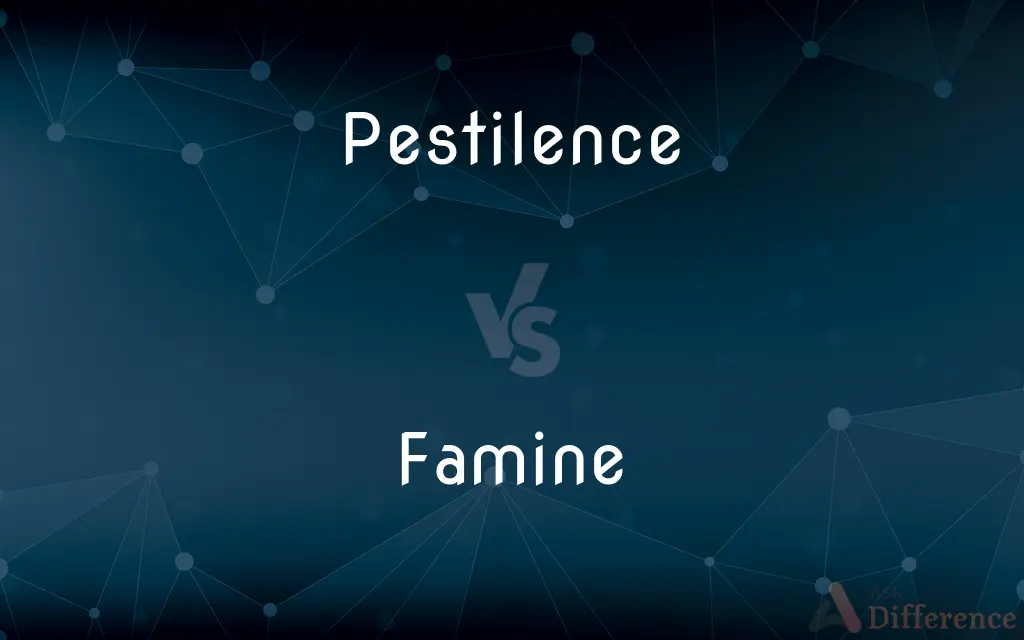Pestilence vs. Famine — What's the Difference?
By Tayyaba Rehman & Fiza Rafique — Updated on April 6, 2024
Pestilence refers to a deadly epidemic disease, while famine is a severe shortage of food leading to widespread hunger.

Difference Between Pestilence and Famine
Table of Contents
ADVERTISEMENT
Key Differences
Pestilence is characterized by the rapid spread of infectious diseases that can lead to high mortality rates, affecting large populations and often prompting emergency health responses. In contrast, famine results from a severe lack of food supply, caused by factors such as drought, war, or economic crises, leading to starvation, malnutrition, and increased mortality.
While pestilence directly affects the health of individuals through disease, famine primarily impacts the well-being of populations by restricting access to the essential nutrients needed for survival. Pestilence can sometimes lead to or exacerbate a famine if the workforce is decimated or if agricultural production is disrupted. Conversely, famine can weaken a population's resilience to diseases, making them more susceptible to outbreaks of pestilence.
Prevention and response strategies differ significantly between the two. Controlling pestilence often involves medical interventions, such as vaccinations, quarantine measures, and public health campaigns. In contrast, addressing famine requires improving food distribution, enhancing agricultural practices, and implementing economic and social support systems to ensure food security.
Historically, both pestilence and famine have been major drivers of mortality, migration, and societal change, but their impacts and solutions are rooted in distinct domains—health and medicine for pestilence, and agriculture, economics, and politics for famine.
Despite their differences, both phenomena highlight the importance of global cooperation and preparedness in addressing complex challenges that transcend national borders, requiring interdisciplinary approaches for prevention, mitigation, and recovery.
ADVERTISEMENT
Comparison Chart
Definition
A deadly epidemic disease.
A severe shortage of food.
Primary Cause
Infectious agents (viruses, bacteria).
Lack of food supply due to various factors (e.g., drought, war).
Main Impact
Health, leading to illness and mortality.
Nutritional, leading to hunger, malnutrition, and mortality.
Prevention/Response
Medical interventions, quarantine, public health measures.
Food distribution, agricultural improvements, economic support.
Historical Significance
Major driver of mortality, can disrupt societies.
Causes mass suffering, migration, and societal change.
Compare with Definitions
Pestilence
A widespread epidemic of a deadly disease.
The Black Death was a pestilence that decimated Europe's population in the 14th century.
Famine
Extreme scarcity of food leading to widespread hunger.
The Great Famine in Ireland resulted from a potato blight and poor political decisions.
Pestilence
Disease causing mass mortality.
The 1918 flu pandemic was a pestilence that affected one-third of the world’s population.
Famine
Condition where populations suffer from malnutrition.
During the famine, many suffered from diseases related to malnutrition.
Pestilence
A calamity involving widespread illness.
Pestilence can rapidly deplete a community's healthcare resources.
Famine
A result of environmental and human factors.
Famine often follows prolonged droughts, wars, or systemic economic failures.
Pestilence
An outbreak causing significant health crises.
Cholera pestilence often struck crowded cities with poor sanitation.
Famine
An acute shortage of essential nutrition.
International aid aims to alleviate famine by providing food and resources.
Pestilence
A rapid spread of infectious disease.
Advances in medicine aim to prevent the kind of pestilence seen in historical epidemics.
Famine
A crisis caused by failed crops and economic hardship.
Famine conditions worsened as the drought persisted, destroying the harvest.
Pestilence
A usually fatal epidemic disease, especially bubonic plague.
Famine
A famine is a widespread scarcity of food, caused by several factors including war, inflation, crop failure, population imbalance, or government policies. This phenomenon is usually accompanied or followed by regional malnutrition, starvation, epidemic, and increased mortality.
Pestilence
A pernicious, evil influence or agent.
Famine
A drastic, wide-reaching food shortage.
Pestilence
Any epidemic disease that is highly contagious, infectious, virulent and devastating.
Famine
A drastic shortage; a dearth.
Pestilence
(archaic) Anything harmful to morals or public order.
Famine
Severe hunger; starvation.
Pestilence
Specifically, the disease known as the plague; hence, any contagious or infectious epidemic disease that is virulent and devastating.
The pestilence That walketh in darkness.
Famine
(Archaic) Extreme appetite.
Pestilence
Fig.: That which is pestilent, noxious, or pernicious to the moral character of great numbers.
I'll pour this pestilence into his ear.
Famine
(uncountable) Extreme shortage of food in a region.
Pestilence
Any epidemic disease with a high death rate
Famine
(countable) A period of extreme shortage of food in a region.
Pestilence
A pernicious evil influence
Famine
(dated) Starvation or malnutrition.
Famine
Severe shortage or lack of something.
Famine
General scarcity of food; dearth; a want of provisions; destitution.
There was a famine in the land.
Famine
An acute insufficiency
Famine
A severe shortage of food (as through crop failure) resulting in violent hunger and starvation and death
Common Curiosities
What are common responses to pestilence?
Responses include medical treatment, vaccinations, quarantine measures, and enhancing public health systems.
Can famine increase susceptibility to pestilence?
Yes, famine weakens individuals' nutrition and health, making them more vulnerable to diseases and outbreaks of pestilence.
How do societies address famine?
Addressing famine involves improving food availability through agricultural support, economic aid, and enhancing distribution systems.
What role does international cooperation play in combating these issues?
International cooperation is crucial for providing aid, sharing knowledge, and implementing strategies to mitigate pestilence and famine.
What distinguishes pestilence from famine?
Pestilence is an epidemic disease causing widespread death, while famine is a severe food shortage causing hunger and malnutrition.
Are there any successful examples of overcoming pestilence or famine?
Successful examples include eradicating smallpox (pestilence) and significantly reducing famine through improved agricultural practices and international aid.
How can pestilence lead to famine?
Pestilence can lead to famine by reducing the workforce, disrupting food production and distribution, and straining resources.
Have pestilence and famine affected historical events?
Both have significantly influenced history, causing demographic changes, migrations, and shaping societal structures.
Can economic policies influence the occurrence of famine?
Yes, economic policies significantly impact food distribution and availability, and poor policies can lead to or worsen famine conditions.
How do cultural perceptions of pestilence and famine differ?
Cultural perceptions vary, but both are often seen as severe calamities that require collective action and humanitarian response.
How do prevention strategies differ between pestilence and famine?
Prevention of pestilence focuses on health measures, while famine prevention targets food security and agricultural sustainability.
What technological advances help combat pestilence and famine?
Advances in medical research, agricultural technology, and logistics have improved the ability to fight diseases and ensure food security.
How do climate change and global warming affect pestilence and famine?
They exacerbate conditions for both, with changing climates influencing disease vectors and agricultural productivity, leading to increased risks.
What is the impact of war on pestilence and famine?
War can directly cause both by destroying healthcare infrastructure and food production, leading to increased disease and hunger.
What challenges do pestilence and famine pose in the modern world?
Despite advancements, they remain threats due to factors like climate change, conflict, and emerging diseases, requiring ongoing vigilance and adaptation.
Share Your Discovery

Previous Comparison
Fang vs. Claw
Next Comparison
Necklace vs. PendantAuthor Spotlight
Written by
Tayyaba RehmanTayyaba Rehman is a distinguished writer, currently serving as a primary contributor to askdifference.com. As a researcher in semantics and etymology, Tayyaba's passion for the complexity of languages and their distinctions has found a perfect home on the platform. Tayyaba delves into the intricacies of language, distinguishing between commonly confused words and phrases, thereby providing clarity for readers worldwide.
Co-written by
Fiza RafiqueFiza Rafique is a skilled content writer at AskDifference.com, where she meticulously refines and enhances written pieces. Drawing from her vast editorial expertise, Fiza ensures clarity, accuracy, and precision in every article. Passionate about language, she continually seeks to elevate the quality of content for readers worldwide.
















































